Product management, in the digital sense, is a recent discipline.
We adopt and adapt concepts from other disciplines like marketing, design, sciences and engineering. We use different concepts for different situations, but also the same concepts in different situations - it depends, right?
This isn’t necessarily a problem, as the intention is always to bring clarity to the context we are operating in, and we should be in constant exploration and experimentation as we find best practices to support our role.
Today I would like to bring you the concept of product vision and how it works within the company context.
Personally, I have been torn about it, so aside from the usual research, I also consulted with some of the best product leaders about it to get their perspective on the matter.
We will start by breaking down the “vision” concept:
how it can be used as a powerful instrument of change,
how to avoid inconsistencies, and
how to create a successful vision.
We will then look at the company context and how the product vision should be set to be aligned with the organization.
Finally, we will identify the most common causes for misalignment between company context and product vision and we will learn how to re-align them.
An inspiring vision
To put it simply, a vision is the communication of a future that drives and inspires people. It should:
be aspirational, yet believable;
it should give people a purpose and make them excited about seeing that vision becoming a reality;
answer questions such as “why does it matter?”, or “why should I fight for this cause?”.
A good vision statement will be made of a compelling fusion of words, inspiring everyone towards that ultimate transformation you want to see in the world. Saying this, a good vision doesn’t have to be a statement at all. If you want to be really effective in communicating this vision, a video, a mood board, a storyboard, or a combination of all the above is ideal to reach your audience.
The goal will always be to share it and evangelize it with a specific audience, to help them see that vision, believe in it and work towards it. Of course, this will only work if this vision resonates with the audience and how they process information.
Finally, let’s not forget that a good vision will also be memorable. People might not remember the whole story, but the underlying principles should remain in their minds as the thing to look up to.
How to put any type of vision together?
When I think of an outstanding Vision, I think of Dr MLK's famous words "I have a dream" - I don't think "fill in this template".
However, not all of us have been touched by any of the 9 muses and so a template can be a good starting place (I’ll come back to the template topic later in the article). In the meantime, there are 3 things that can help you with getting into a vision mindset:
1. Be clear
You want to be sure you are clear to your audience. You want them to visualize what the future will be like and they want to see and feel the change you / your organization will be introducing into people’s lives.
Why does this change need to happen, who will be the people most impacted by the change and how the world will be different for them.
Clarity also gives people confidence in your ability to lead the delivery of that vision, in their own ability to deliver that vision with you.
2. Do your research
The Vision is meant to set the tone for the next 5 to 10 years.
While no one is expecting you to become a “future guru”, you should look at understanding:
Who your target audience is and what they struggle with today;
What the external signals are telling you: how is the world around you behaving and responding (politically, economically, etc.)? What have other people been saying?
Which trends are emerging and what is the predicted impact they will have;
Why - why now, why you.
This research gives the grounds and context you need to put a vision together, but it should also be part of your storytelling - a vision without context is meaningless.
3. Know what you stand for, genuinely
One thing most inspiring people will have in common is that they have clear values.
The theory of basic individual values is a redefined framework which allows for some self-reflection of the values you hold as an individual, your underlying motivations and goals. These are meant to be values recognised across all societies, as they’re based on basic human needs: individual, societal and survival.
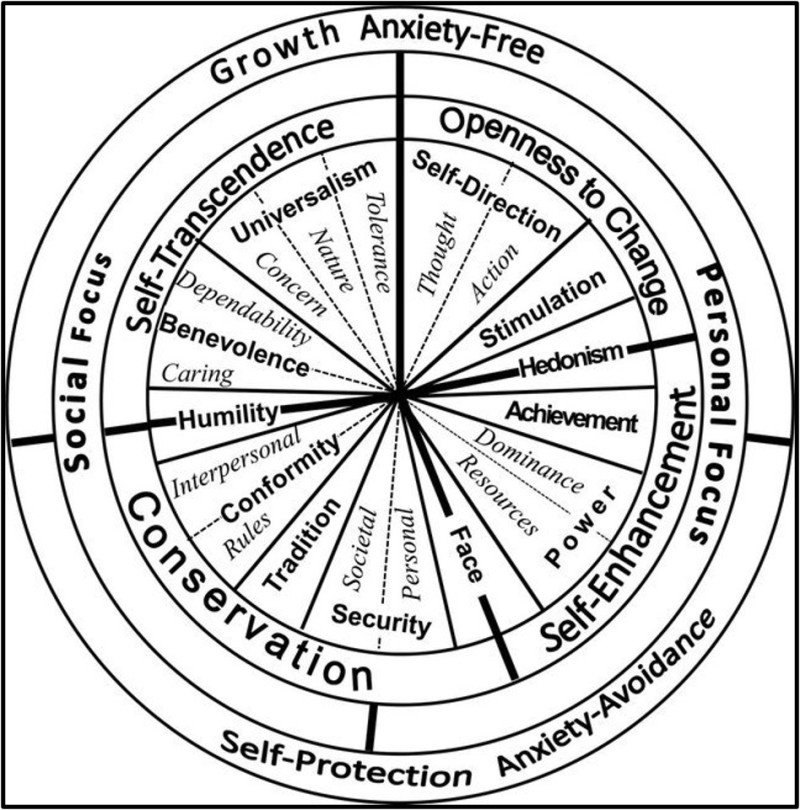
If you could highlight what you value from the wheel, what are the underlying motivations? Do you see conflicting underlying motivations like “Conservation” and “Openness to Change”, for example, what does that mean - is it a matter of context?
- Is this contrast part of your story and what makes you human?
> How will you use this information to build & communicate the vision?
I know I said “3 things”, but if you’re feeling stuck, without much inspiration, this last point might help:
4. Read & listen to what others have written & said
Don’t limit yourself to reading companies' vision statements, there have been many inspirational leaders who have used the power of their words to “shake things up”.
After each speech or statement, think about what they said, how they said it and how it made you feel: did it move you, did it revolt you, did it make you feel passionate about what they said? - Why?
Focus on the power words held and how, people who never met you (and you’ll probably never meet) briefly held control of your emotions. How did they do that?
How does it all apply to companies and products?
Now that you know about vision as a concept, let’s see how that relates to a company and to a product.
Company (vision) mission
Companies have missions. Mission and/or purpose will be the terms used within the “about us” pages across most company websites.
I agree that most of the articles you read about mission, vision, and purpose statements can be contradicting - a lot of other product leaders I chatted with agree this can be a confusing topic. At the end of the day, you should choose what works for you and your organization, but do avoid contradictions.
Having a product vision and a company vision is contradictory in the sense that if the vision’s “job” is to align an organization, you might be creating a repetition, therefore wasting work; or a contradiction, by sending the product team one way and the rest of the organization the other way.
Now, you might be wondering whether “mission” is less meaningful or important than vision. On the contrary: the mission provides a great part of the context needed to carry out the product vision.
In the Product Roadmaps Relaunched book, the company mission is described as the “intent an organization holds, today. …It is the purpose driver and states what it will do for someone else”.
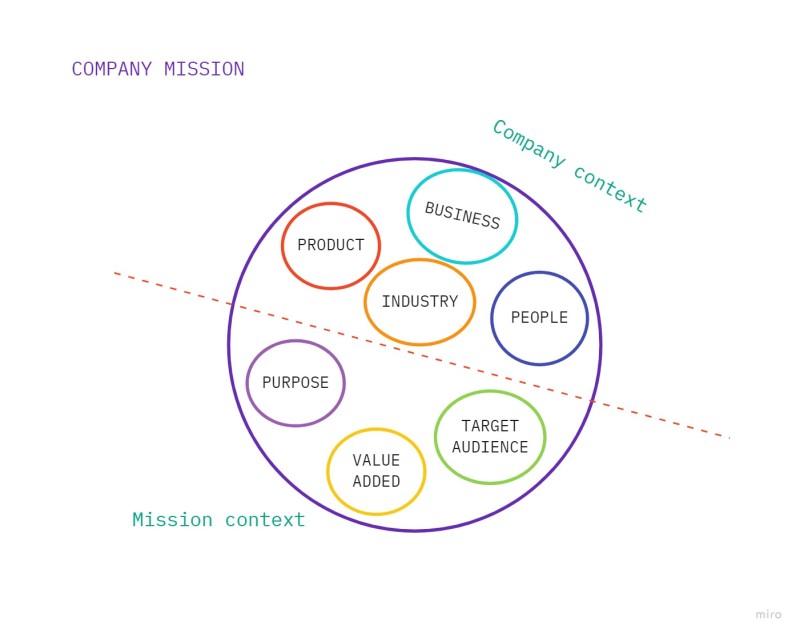
The mission statement defines the company’s purpose and it should help every department in the company when having to make a decision, answering the question: “are we staying true to our mission?”.
One of my favorite company mission statements, for example, is Hubspot’s:
“There's this notion that to grow a business, you have to be ruthless. But we know there's a better way to grow. One where what's good for the bottom line is also good for customers. We believe businesses can grow with a conscience, and succeed with a soul — and that they can do it with inbound. That's why we've created an ecosystem uniting software, education, and community to help businesses grow better every day.”
Not only do they clearly state their mission, but they also help other organizations succeed at theirs, in a sustainable manner. It’s almost like you automatically become a better business just because you hire Hubspot as your CRM platform.
How does a company mission impact the business day-to-day?
Company mission represented in strategy
Earlier, we mentioned the importance of clarity and context in setting a vision. Well, the mission is what makes Microsoft different from Apple, and how they both differ from Google’s mission, for example.
Microsoft’s mission (2022)
“Our mission is to empower every person and every organization on the planet to achieve more.”
Apple’s mission (2021)
“Apple strives to bring the best personal computing experience to students, educators, creative professionals, and consumers around the world through its innovative hardware, software, and internet offerings.”
Google mission statement (2022)
“Our mission is to organize the world’s information and make it universally accessible and useful.”
Even though all three companies produce similar physical and digital products that solve similar problems, we know how they are different. The emphasis, care and attention each business gives to each product area, how they’re known for different benefits & downsides, how they prioritize, and their style and approach to business overall are based on their mission.
For example, when thinking about their mobile strategy we know the 3 companies have decided to take on very different approaches.
While Apple, to ensure consistency across their customer’s “computing experience”, has decided to uniquely sell their OS system with their own devices; Google, on the other hand, as it values making information accessible to everyone, prioritized selling their OS separately from their hardware.
Microsoft, however, held the famous mission "A computer on every desk and in every home" until about 2013, making them a little late to the mobile party.
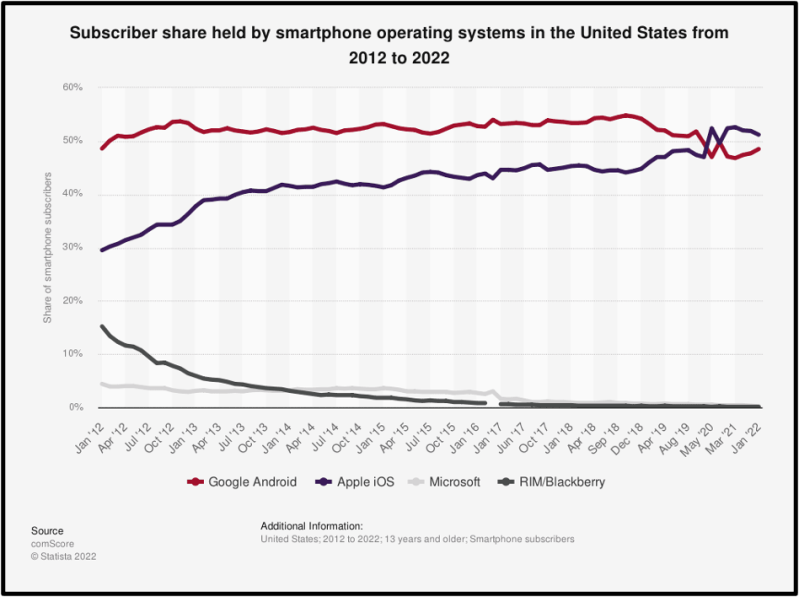
Company mission represented in staffing
It is also relevant to mention that having a good mission, aided by strong company values, becomes a good test of employee-organization cultural fit.
For example, there has been a growth in the number of software companies that identify themselves as mission-led, or mission-driven companies. Traditionally, these have been organizations that want to have a meaningful and positive impact on social and environmental causes, like Free From.
More recently, the definition has widened to consider companies that use their mission as a commitment to serving their customers and their needs, while playing a wider role in society.
Aside from showing a purpose to their customers, it also works as a way to retain and hire the staff that will feel highly involved in serving this mission.
Taking Wise’s mission, as an example:
“Money without borders - instant, convenient, transparent and eventually free. We’re powering money for people and businesses: to pay, to get paid, to spend, in any currency, wherever you are, whatever you’re doing.”
This is a company that disrupted the international transfer market and understood the pain involved (emotional and financial) in the need to make an international transfer. If you have felt this “pain” before, or if you believe in having open financial borders, it is likely you would feel compelled to work for Wise.
Companies that have strong, clear and meaningful mission statements have been able to hire and retain good quality staff to their teams. Even if larger organizations may provide bigger salaries, some people are motivated to join an organization that is actively making a positive difference in the world and refusing to grow at the expense of people and the planet.
> Do you know what your company mission is? Did it play a part in your choice to work for them?
Who owns the company mission?
Normally, the CEO, or founding team, will own the company mission. They will not be alone in crafting a powerful mission statement, the marketing lead and/or team will be supporting the CEO with process, as the mission is what sets the pace both internally and externally.
Internally, the mission will be providing context to the actions carried out by all teams and departments. Externally, however, the mission is what your customers will use to confirm that you are here to stay and that they can trust you. The marketing team will be the best placed to help craft the statement and create holistic and consistent campaigns around it.
Product vision
For a lot of tech companies, their products are their business.
The way they grow is by growing their customer base, the underlying business model depends on how the product is “consumed”, their customer acquisition strategy lies in learning and understanding who their customers and/or users are, what their journeys and needs are so the product meets them and adds value to them.
Having a clear, well contextualized and inspiring product vision can be one of the most powerful mechanisms to unite, motivate and align a whole organization.
As the authors of the Product Leadership book put it, “the best product visions are timeless and disconnected from the technology they are built on”.
I have even seen this happening with early-stage businesses I have worked with: the underlying solution and strategy might change and the business might iterate, but if the vision stays the same that means that it is doing its job - providing a product direction, regardless of its underlying technology.
Aside from the vision fundamentals already considered, a strong product vision:
Shows the transformation your product will bring to your customers and users - what the future looks like for them, not the details of how you get there.
Helps the organization visualize the future they will be working towards - it can be incredibly powerful with hiring and retaining talent, as people align themselves with that ultimate goal and want to be part of that change engine.
Guides the different strategy angles, from product discovery to go-to-market strategies, so it must be set in the long-term (ideally 5 to 10 years out, depending on the size / age of the organization)
In SVPG, you can find great examples of what a good product vision can look like.
One of my personal favorites is Asana’s Vision; you can tell it has a clear understanding of the main alignment issues an organization faces as a whole, but I also appreciate how they don’t forget to mention how they will improve productivity for teams and individuals.
You can also see how they don’t necessarily mention the underlying technology but how the visuals complement the narration, as they allude to how they are proposing to solve everyday issues and normal friction points.
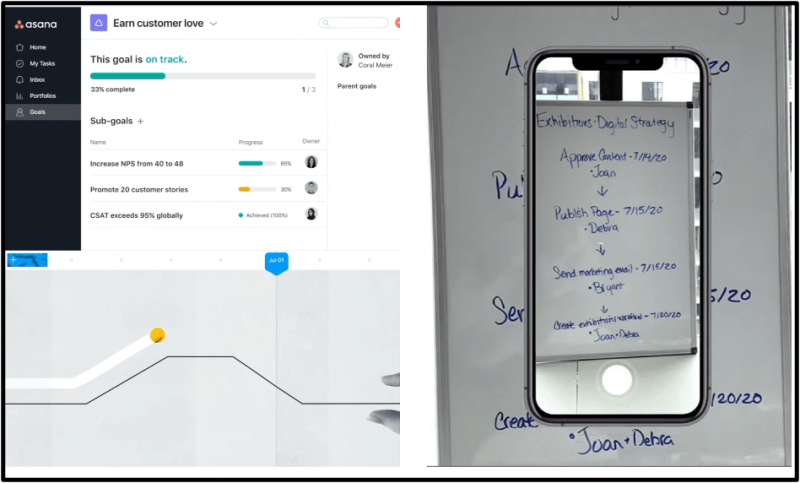
Who should own the product vision?
The product leader in the organization should own the product vision, but it will be far more efficient when inviting other organizational leaders to contribute to it, especially the CEO or the founding team.
You might be wondering how that leaves the product managers, who might also be owning one or more product lines. They need to be actively contributing and realizing the overall product vision, and it’s the responsibility of the product leader to ensure this happens.
Based on the examples used to clarify the notion of Product Vision, you can identify that creating an efficient product vision that will influence the whole organization towards change is more than a “box-ticking” exercise. It is a decision that will define the work for the next 5 to 10 years (depending on the size of the organization) and so it should take time and consideration. Therefore asking every single product person to elaborate a vision of their own is an extraneous and expensive task.
How to build the ultimate product vision?
Gather your context
As Marty Cagan puts it, the biggest inspiration for your vision starts from having a deep understanding of your customers, your business, your products and your data.
Then, the product leader will have to do a lot of outwards looking research. From understanding what is happening with the competition and adjacent businesses in the market, to looking out to the overall industry.
Build a compelling story
Once the product leader feels like they’ve gathered enough internal and external context, they should get together with the design team, or design leads, as they are the experts in storytelling.
The team can choose to share a video, or a storyboard (depending on the time and skills available in the team), but the idea should be to clearly communicate:
1. Who
Who will be the main person / group of people (mainly in a B2B or Marketplace contexts) affected by the transformation your product will bring
This is especially important to inform business models, pricing and go-to-market strategies (marketing a product to a student will be very different to marketing that product to a corporate business)
2. How
How the product will add value to this person / group of people
You will need to be clear about how the product deliver value, while keeping it as an idea that can become any of the many solutions the product teams will find within the context and constraints
Remember that this is meant to set a future vision, so technology will play a supporting, not leading role. The technology used to support the product vision is always to communicate an idea and support how the product, or combination of products, will add value.
3. Don’t forget that “wow” factor!
This is a concept introduced by Paavan Buddev in one of his talks to ProductTank London, who explores the Hills and Storytelling framework to introduce the “special factor” only your organization can bring to the table.
Make it credible
Bear in mind that lack of credibility is one of the biggest reasons why the product vision is set aside by the people in the company. Either because people don’t believe it aligns with the company’s values, or because they lack the talent and skills - not just from a delivery perspective, but also from a strategic one.
I saw this happening once. I was working for a company that had released their product vision 8 months before I started. The video should’ve been shown as part of my onboarding process, but it had only been shown once and it was met with a lot of resistance from the employees. No one believed in the futuristic product vision because the business was known for its traditionalist views and approach to product. It was put away, as it caused more problems than it helped.
Product Vision templates
There are some interesting templates available to help, as a starting point. Nevertheless, I would suggest you go deeper in your approach if you really want to be successful in creating and communicating your vision.
A simple and effective starting point can be the approach suggested in Product Vision 2020, which you can do in a workshop. You get the chance to gather some high-level ideas of the wow factor in your product, align on who the target customer is and how you will be delivering value.

Another very interesting method to get the ball rolling around storytelling and ideation, is the one shared by Ilya Leyrikh, Product Lead at Wise.
This technique gets the group to, first, identify the main reasons why a customer considers your product. Then, it moves on to call out the very best way those customer needs could be served. You end up defining the “end goal”, the vision, for that product. You also set a clear reason to why working towards that goal is the most important thing to achieve - to ensure customers keep selecting your product.
There are other interesting templates available, I am sure you know, so feel free to use them if you feel stuck and you are faced with “the white page doom”, but keep in mind that this is only a starting point and not the finish line.
Do you always need a product vision, or should there be more than one product vision?
Smaller and/or younger companies
In most young software companies the solution they offer is the main reason why they started a business in the first place, so the company mission and product vision will tend to be one and the same.
It is also worth considering that a lot of these young organizations’ focus will be on surviving a busy market space - spending a lot of time on crafting the most eloquent company mission & product vision statements won’t be on top of their priorities. It is important to know where the business is going so the small team can focus on what matters the most, but there are very little issues around alignment.
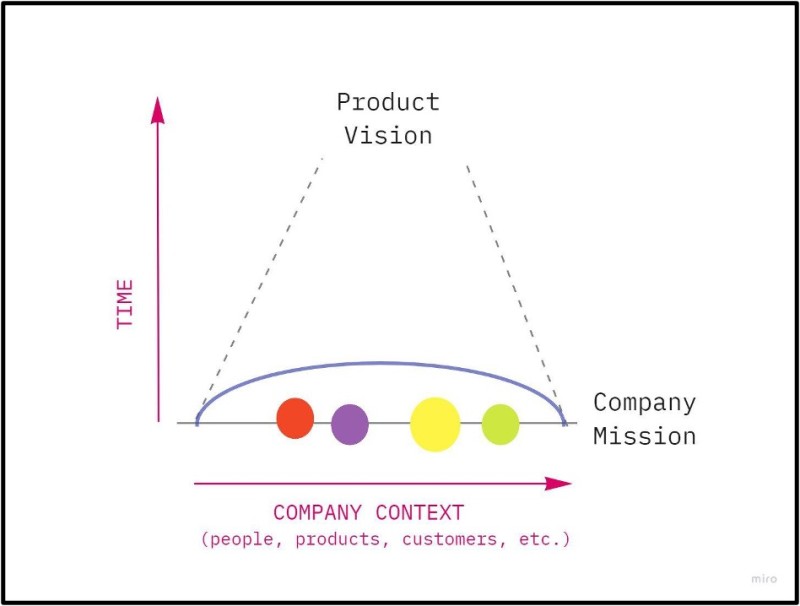
As the organization grows...
Having a clear product vision definitely plays a more significant role when the organization grows and there are more people and more systems to align.
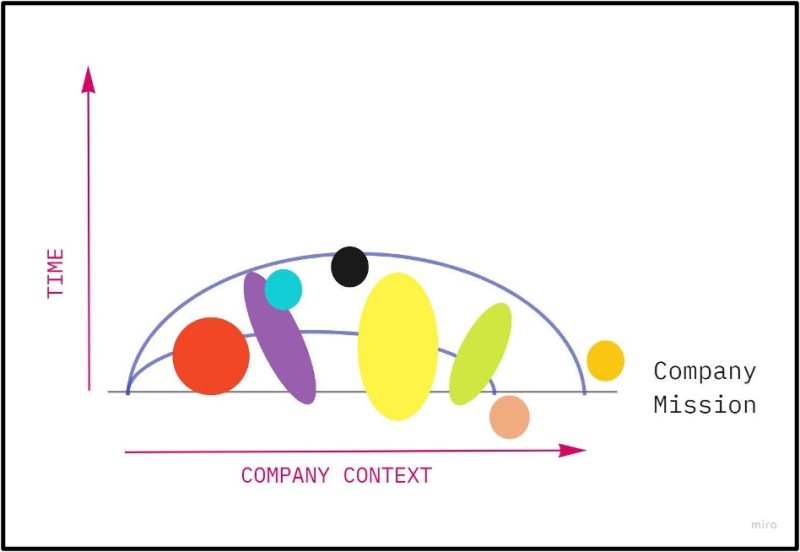
A lot of the product leaders I spoke with (including myself) confessed to the fact that they weren’t properly sold on the idea of a product vision - until they needed something to rally their team(s) around a higher and more ambitious objective.
Most of us will be working in a company where the role of product isn’t so well understood and we will try our best to adapt certain product concepts in the best way we can and know.
Overall, our goals will be to make sure that everyone who’s involved in the product work will feel as empowered as they possibly can - crafting a product vision can be a good way to achieve this, especially in organizations going through a transformation.
For example, if a team is being tasked to do some “uninspiring” work, like integrations, or internal tools, it might be useful to have a product vision for this team. Aside from providing this team with a higher goal, more enveloped in the company mission, having a vision will also help us in negotiating higher budgets and in prioritizing this work to be done.
It is worth mentioning that this can be a consequence of an organization that doesn’t have a clear understanding of how all teams play a crucial part in delivering the ultimate vision, so there might be a need to look again at the team topology. However, this can be a lengthy and expensive process. While I believe there should only be one Product Vision for the company, I also agree that some product people are sometimes tasked to play difficult roles and that we should use all tools available to see a team succeed.
Multiple product visions?
The biggest misunderstanding I see around the theme of the Product Vision is when each product team is mandated to have a different one. From an organizational perspective, you can create a lot of confusion, as other stakeholders struggle to see how everything fits together. It might also generate needless competition between teams. The biggest issue, though, is in what it does to the product manager (or product owner), as it adds unnecessary pressure to create and evangelize this product vision. Once again, this might be a consequence of a company that isn’t able to find alignment across their initiatives and the pressure falls onto the product people in each team to find answers for themselves.
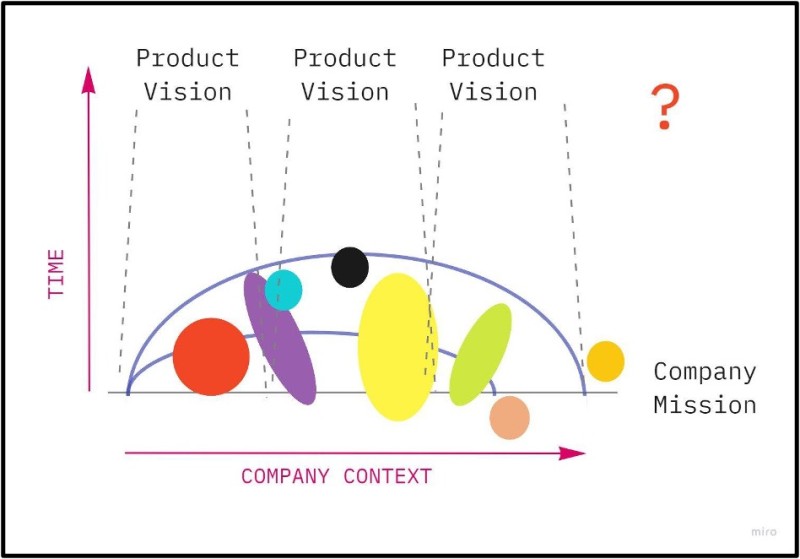
We know, however, that some organizations are larger than small countries and so you need to find strategies to give control to the teams managing different product areas.
The product leader, in this case, would need to stay very close to the other product leaders to avoid misalignment in the product vision, while, at the same time, ensure their participation is considered, as they will have a better understanding of their product area and customers.
Great leaders should recognize when the product structure needs to be adjusted and optimized for business clarity, as it might be impacting the benefit it is delivering to its customers.
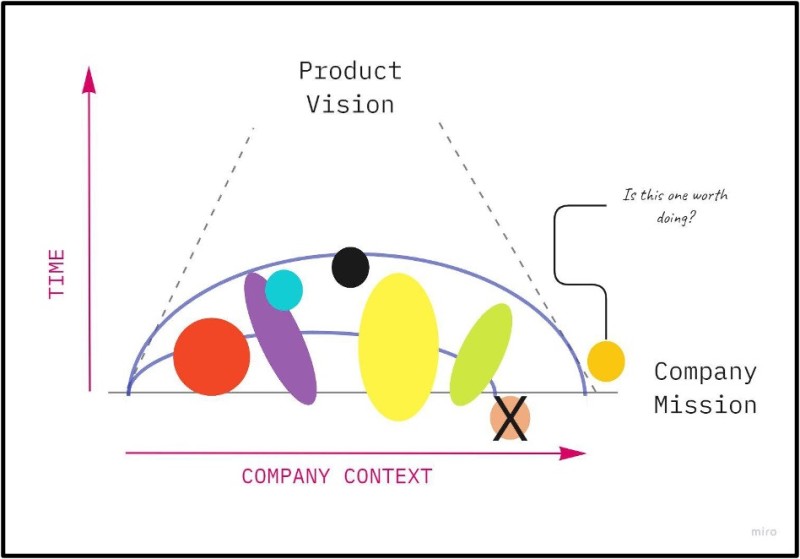
As we know, the answer to a lot of product management questions is “it depends”, but having one single Product Vision per company (or entity) is ideal.
It is especially important to remember here that the Product Vision isn’t solely for the product organization, it will also inform strategy, which is dependent on other parts of the business. Having more than one product vision is confusing and it will contribute to misalignment - causing a lot of prioritization problems later on.
How to align company mission and product vision
Earlier we mentioned that one of the biggest anchors for the product vision is the company mission, so you’d assume that it would be unlikely for a misalignment to happen - but it does happen.
In this section, we will identify the biggest causes of the misalignment and how to get them back in line.
Causes for misalignment and how to find alignment
Mergers & Acquisitions (M&A)
The company might identify that the most effective way to carry out its mission is to acquire other products and/or companies that might be doing a great job at solving a specific problem.
Depending on the speed of the acquisition program, the size of the company acquired (or merged), or on the number of companies acquired, we might find “a disturbance in the force”.
You can quickly identify how this can cause misalignment: each product acquired will have its own vision, and each company acquired will have its own mission.
Experiment opportunity
It is important to state that this is potentially one of the most delicate situations you will find. It is natural for people to feel threatened, and for every meeting and conversation to be met with some anxiety (possibly rightfully so).
The Product Leader(s) and teams shouldn’t face this on their own, but it doesn’t mean they cannot play a big part in finding this alignment.
After the new company mission is confirmed and agreed (it might need to be adjusted or clarified) and with the leadership team direction, it is important that the Product leader(s) confirm and agree on the product vision.
The product vision can be improved, with the acquisition of better and improved technology perhaps. It can also happen that there is an interesting opportunity to go after an adjacent target customer, that will enable the rest of the product team to grow as well.
It is important to re-introduce the product vision and the company mission during these times, as there might be a lot of changes in the organization. People will look for direction and these tools are the best to revisit that direction.
Product discovery “gone too far”
Given a problem to solve, an empowered team will look for the most valuable and efficient solutions to solve the problem, based on the context and constraints provided.
One of the best examples of this situation is the story of how AWS became what it is today. As the team saw itself unprepared to tackle scale and they found a solution to a problem that a lot other people in the tech industry had: setting up a new project from scratch every time, including adding a database component was lengthy and expensive. The rest is history, but as many of you might know, this is
I wonder if when Jeff Bezos, in 1994, set out with the mission of being “the everything store” also meant “cloud computing services”...
Alignment opportunity
The great thing about experiments is that they are experiments, i.e., they might not have the expected result companies might expect to have. But an experiment that yields further market opportunities can positively disrupt a business.
This is a great opportunity to assess both product vision and company mission. Normally, the question depends on the return on the investment of going after something completely different to what the business has set to go after initially. If the opportunity can be profitable, and there is trust in the business.
The product vision will grow as the company grows. Logically speaking, the larger the company, the more impact it can have in the world.
The company is going through a digital transformation
This can be one of the longest processes for an organization and it can take many shapes and forms. The angle I want to bring up is in the context of product leading a company transformation.
In this case, the product vision will be the biggest inspiration tool for the organization and it can easily and quickly shift the mission statement, as the business might decide to serve different customers, markets, etc.
Think of all the businesses that have gone through successful digital transformations, mainly around turning “paper-based” businesses into digital businesses.
Alignment opportunity
Product leader working closely with the commercial and financial teams and the CEO to ensure this new mission has a large enough purpose to also bring their customers and stakeholders along the journey.
This is a line to tread with caution, as this business might have to make some very difficult business choices, like choosing some customers over others and closing down product lines.
Gaining the confidence from the leadership team will be essential, while also conquering the rest of the business that might be weary of the changes will be crucial - having a well-designed product vision will definitely help with clarifying where the business is headed and how each product line will play a crucial part in carrying out the vision, supported by the renewed mission.
Final thoughts
Frankly, I haven’t been much of a fan of product vision as a concept.
Aside from not having seen it done properly, it is a theme that quickly descends into arguing around semantics and I simply didn’t find it useful.
Nevertheless, staying true to a product-thinking mindset, I approached the theme with curiosity and humility - especially when there’s so much published content about it!
I went deeper, did the research, and took it to the experts - aka, the people in the product community.
What really solidified it for me was looking for answers around the best product leaders, including the SVPG members, especially Lea Hickman, who was able to clarify the subject with case studies, along with best and bad practices.
I have learned so much, so I hope you stay open to learning and asking questions, no matter how dumb it might make you feel.

Inês Liberato

Read also
Experience the new way of doing product management






